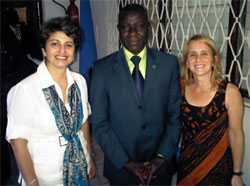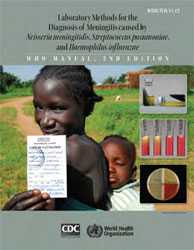Division of Bacterial Diseases (DBD) News Bulletin
This website is archived for historical purposes and is no longer being maintained or updated.
January 4, 2012: Content on this page kept for historical reasons.
In This Issue
A Year in Review
- Quarter 1
- Quarter 2
- Quarter 3
- Quarter 4
- 2012 Events
Winter 2011
Quarter 4
DBD presented an impressive update on division accomplishments to Dr. Frieden and his staff during the October QPR. Domestic and global activities were included in the 21 new goals for the current fiscal year. Modifications to DBD initiatives in reducing pneumococcal disease in the U.S. and internationally and introduction and surveillance of MenAfriVac™ in Africa were presented, and a new cross-center collaborative initiative to utilize CDC technology for multi-pathogen testing in public health settings was highlighted. See photo below.

Photo: MVPDB’s pertussis epidemiology and lab teams hosted visitors from the Latin American Pertussis Project for a 3 week training.
DBD’s MPIR Laboratory completed a proof of concept project to use Dried Blood Spots (DBS) as the sample matrix for emergency response assays. The anthrax anti-PA IgG ELISA assay was modified to work with DBS with comparable accuracy and precision to serum. DBS samples have significant advantages for ease of collection and transport, which are especially advantageous in emergency response or when dealing with pediatric or other special populations, as well as for returning samples from remote areas. The success of the pilot program has led other labs to develop DBS methods for use in studies where collection and transport of serum is cost prohibitive, such as meningitis in sub-Saharan Africa. DBD received funding from BARDA to establish, with OPHPR, a multi-Center (NCEH, NCEZID, NCIRD) initiative to develop rapid and point of care diagnostics for anthrax emergency response.
As part of the Latin American Pertussis Project, pertussis surveillance coordinators and microbiologists from Argentina, Mexico and Panama participated in a DBD-sponsored training at CDC for three weeks. The training increased the countries’ capacities for pertussis surveillance, epidemiology and laboratory diagnostics. See photo at right.
A study of DTaP vaccine was completed, demonstrating 95% vaccine efficacy within 12 months but waning immunity declining to 70% efficacy by 60 months after the 5th dose of vaccine. In collaboration with the California Department of Public Health, DBD reviewed medical records of more than 4,000 children from 15 California counties during the state’s 2010 pertussis epidemic and reviewed these medical records during personal visits to more than 250 medical practices to read through each chart. The final analysis included more than 600 children with pertussis and more than 2,000 children without infection in a comparison group.

Image: Banner displayed at CDC main entrace. 2011 marked the first anniversary of the introduction of new pneumococcal conjugate vaccines in developing countries.
2011 marked the 3rd annual World Pneumonia Day and first anniversary of the roll-out of new pneumococcal conjugate vaccines in the developing world. DBD helped coordinate worldwide activities, posted information on CDC’s internal and external websites and social media accounts, published a MMWR announcement and displayed a co-branded banner over the main campus entrance. See banner at right.
To support implementation of the 2010 prevention of perinatal group B streptococcal (GBS) disease guidelines, DBD conducted formative research with laboratorians who process GBS specimens. Based on this research, new tools were created and posted on the CDC GBS website that highlight key steps to avoid false negative results when processing specimens. The GBS team is developing an interactive app for pediatricians and obstetricians to support implementation of the guidelines.

Photo: In Bangui, Central African Republic at the SURVAC steering committee meeting: DBD’s Rana Hajjeh with the Minister of Health of CAR, Monsieur Jean Michel Madamba and Linda Venczel from the Gates Foundation.
DBD staff attended the SURVAC steering committee meeting in Bangui, Central African Republic to review progress and discuss work plans for next year in the 3 countries that the project focuses on (DRC, Cameroon and CAR). After more than 7 visits this year, 2 of 3 countries have implemented PCR and are turning out data. DBD supports sentinel surveillance activities for invasive bacterial disease in the 3 countries, all of which have recently introduced PCV13. Cameroon is introducing meningococcal vaccines this fall.
The 4th annual Get Smart About Antibiotics Week was in November. A MMWR article on new data on antibiotic prescribing trends in children was published. The program received a formal greeting from President Barack Obama. DBD collaborated with DHQP on a press release, fact sheets, a live Twitter chat with ABC News’ Dr. Rich Besser, postings on CDC’s internal and external websites and social media accounts, a Hill Announcement to U.S. congressional staff and a MMWR Announcement.
Five of the 11 Epi-Aids DBD responded to were in Q4: Legionnaires’ disease in the Virgin Islands, group A Streptococcus in Georgia, mycoplasma in West Virginia, pertussis in Maine and pertussis diagnostics in Arizona.
DBD staff visited Western Kenya for its research study on newly available clean cookstoves in rural villages. Data from this study will aid the work of governments and others in combating respiratory diseases. DBD, along with partners, will gather data that can help key stakeholders to better understand factors that may influence a family’s decision to purchase and routinely use a clean burning stove, and gauge the potential of the most promising interventions for large scale, sustainable adoption, manufacturing and dissemination in Western Kenya. See photo at right.

Photo: RDB’s Jennifer Loo boiling water on a clean burning cookstove to prepare Ugali—a traditional Kenyan dish made from maize and water —with Steve Kola from the Kisumu, Kenya Safe Water and AIDS Project (SWAP).
DBD epidemiologists worked with the Accelerating Vaccine Introduction Technical Assistance Consortium (AVI TAC) Special Studies Team to complete large reviews of available evidence on PCV schedules for children in various areas of the world (the “landscape project”) and on the impact of PCV use on vaccine- and non-vaccine-type invasive pneumococcal disease (the “serotype replacement project”). DBD staff led expert meetings in Geneva, Switzerland in October to review the findings. Conclusions of the investigations were presented at the WHO SAGE meeting in November.
SAGE published a meningococcal disease position paper recommending that countries with high or intermediate endemic rates of meningococcal disease and countries with frequent epidemics introduce large scale vaccination programs using meningococcal conjugate vaccines. DBD work with ACIP and vaccine introduction in Africa contributed to this position paper.
Several staff from DBD attended the Aetiology of Neonatal Infections in South Asia (ANISA) project’s Second Investigators’ Meeting in Niagara, Canada and a satellite symposium on group B streptococcal disease in developing countries at SickKids Hospital, Toronto. The ANISA field sites are in their 3rd month of piloting. Preliminary data were reviewed, challenges were discussed and criteria were set for graduation from the pilot to the main study. DBD epidemiology and laboratory teams are active members of the ANISA coordination team.
For a new reference standard serum, DBD provided consultations on the characteristics of the assay, designed the bridging studies between the old and new preparations and analyzed the final results. The reference standard serum, lot 89SF, has been used in pneumococcal ELISAs since 1990 for the evaluation and licensure of vaccines. In 2005, it was estimated that there remained between 2 and 5 years’ supply. Since lot 89SF was the reference standard used in the evaluation of PCV7, the link to clinical efficacy would be severed if stocks became completely depleted. A new preparation, 007sp, has replaced 89SF as the pneumococcal reference standard. Sufficient quantity of this new preparation is available such that, with judicious use, it should be available for at least 25 years.

Photo: DBD’s Gina Mootrey, Stephen Hadler, Derrick Lake and Kathy Tatti preparing for the October QPR.
DBD scientists presented and participated in FDA’s VRBPAC meeting that led to VRBPAC vote in support of licensure of PCV13 for use in adults. A final decision by FDA on licensure is pending. DBD scientists and the ACIP pneumococcal vaccine working group completed a review of available data and set goals for additional data that are needed to make a general recommendation for the vaccine’s use in adults.
In collaboration with WHO, DBD laboratorians completed an updated manual on laboratory detection of meningitis. The last manual was issued in 1999 and since then, routine immunization against Hib, meningococcal A, and pneumococcal disease has become a reality or is under deliberation in countries around the world. See photo above.
DBD completed a body of work that culminated in the first successful completion of proficiency tests for use of the TAC/Viia7 platform in the ANISA sites. The projects included developing about a dozen new assays, development and compilation of standard operating procedures, identification and correction of Viia7 software problems, training of sites by webinar, at CDC and in-country, development of a proficiency test panel and development of a positive control plasmid.

Photo: Cover of the 2011 updated manual on laboratory detection of meningitis, which replaces the 1999 edition.
In 2011, DBD enrolled an additional 15 domestic labs and 4 international labs in the ELITE quality assurance program to assess ability to detect Legionellae in water samples. 108 labs are now enrolled in the program. Advertising to international labs began in late 2011 and new participants will receive their first panels in January 2012.
At a December meeting in Annecy, France, the AVI Special Studies team reviewed progress on studies evaluating impact of pneumococcal and rotavirus vaccines, as well as special studies on research priorities for the next few years.
Top of Page- Page last reviewed: January 4, 2012 (archived document)
- Content source:


 ShareCompartir
ShareCompartir